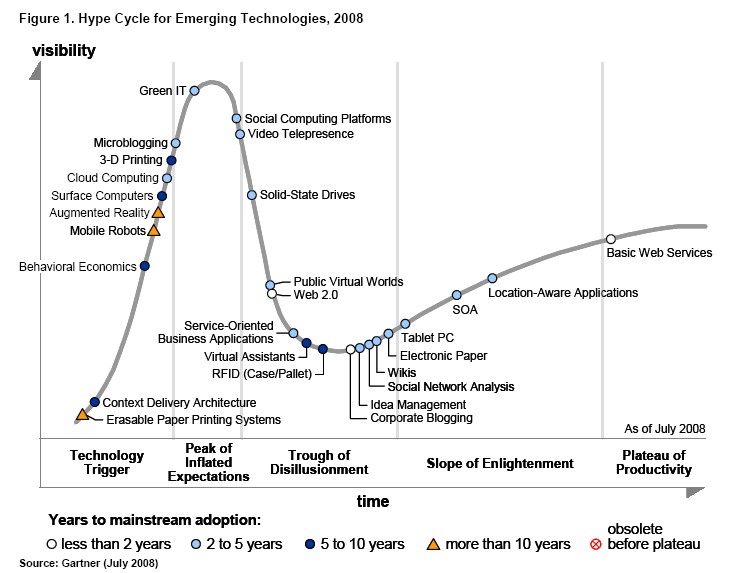Second Life, hype cycles, and reality
So,I’ve been thinking alot this week about what I might write about for this blog post about my current feelings about Second Life. Some of the activities we did this week included visiting interesting Second Life sights and rating them using the SaLamander wiki’s learner engagement rating like experiential, role-play, diagnostic, etc. more info here:http://www.eduisland.net/salamanderwiki/index.php?title=Main_Page
we also spent time learning more about creating objects in Second Life — working with prims, editing and creating scenery, wearing and designing clothes.
we also completed a project in groups of three where we chose a general theme, and then found 15 resources both in world and out of world and gave brief descriptions of these, to help novice and regular users of Second Life to navigate their world better.
So while all this was happening, in the back of my mind I’m thinking about where Second Life is in adoption. One of the articles we read in the first week (Jennings and Collins) used Everett Rogers’ Diffusion of Innovations research to map out technology use and contrasted Early Adopters to Early Majority. They quote an article from Moore that defines behavior differences between these two groups. A few examples:
early adopters favor of revolutionary change, early majority favor evolutionary change
early adopters are visionary, early majority are pragmatic
early adopters are willing to experiment, early majority want proven applications
and probably most importantly:
early adopters are generally self-sufficient, whereas early majority may need significant support
so for those that understand Gartner’s hype cycle, there is a problem inherent in the current place where Second Life is and its future. (original source here: http://www.gartner.com/it/products/research/methodologies/research_hype.jsp)
For those unfamiliar with the curve – a quick pic and summary:

When technologies are first introduced, there is usually a period of inflated expectations: excitement around the new technology. This is where your early adopters would jump on board and get excited. Over some timeframe, there is a period of disillusionment where the process of getting it from a small percentage (5 or 10%) to a larger adoptance is hung up on a variety of factors: ease of interface, cost, flexibility, inflated expectations, applicability, etc.
As larger awareness and usability occurs, it becomes more adopted and it eventually becomes mainstream reaching the plateau of productivity. What is interesting about this curve is that it is not time-dependent. Technologies like augmented reality and mobile robots have been in the first phase of adopting for more than a decade. Other technologies like GPS climbed into fairly high adoptance in just a few years. So where is Second Life here? In this 2008 graphic, Public virtual worlds are in the trough of disillusionment. Some writing and thinking by Gartner indicate it may well be five or 10 more years before these become more mainstream.
…of course, the important question is why?
For a technology to move past disillusionment, there needs to be a crystallization of utility and need that begins to drive more use. We are still at the point in Second Life where a combination of factors keep the utility and need at a minimum.
As many of us have found in traveling virtual worlds, although there is an excitement and engagement in well-designed ones, this is still far from the universal experience. Just as importantly, the requirements to participate, both from a technology and usability standpoint, are still not nearly high enough engage more than a small percentage of technology users.
So what does that mean I think about Second Life at this point? This reminds me a lot of the early days of the World Wide Web. I remember coming back from a 1993 conference having seen the first version of NASA’s demonstration of the Dead Sea Scrolls via a web browser and told our school library and what a transformative experience it was to see artifacts through a graphical interface using the Mosaic web browser. Her response surprised me — I remember her saying that although viewing through a browser might be an interesting experience, users would still need to know protocols like telnet and FTP in order to use the Internet as a learning tool.
I guess that summarizes how I feel about Second Life at this point. I see the promise of an engaging and immersive environment, but realistically see more years (five?) before it begins to climb up slope of enlightenment.
Caveat: of course, when I started playing with Twitter a year ago, I could’ve never imagined it would evolve into the worldwide phenomena it has become in such a short time. Of course, Twitter had some things going for it that enable the quick adoptance. it has a platform that uses SMS, which had just become a mainstream tool, not just for adolescents, but for adults. The ease of use made it much quicker to be adopted as well.
So, maybe there is a seminal moment waiting for the immersive virtual worlds that will push it up the curve — uniform interface between environments? Easier entry point for beginners? Less traffic and bandwidth demand participation? Who knows? Time will tell…
